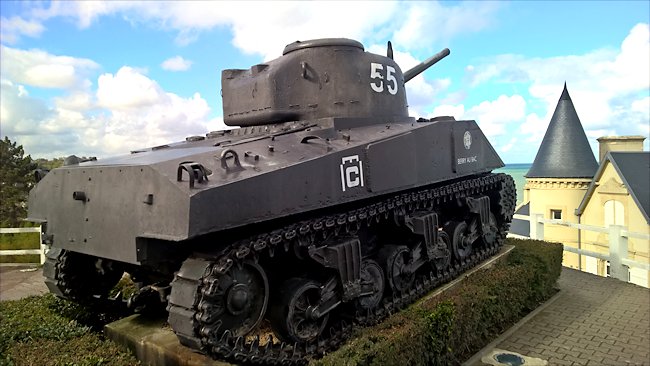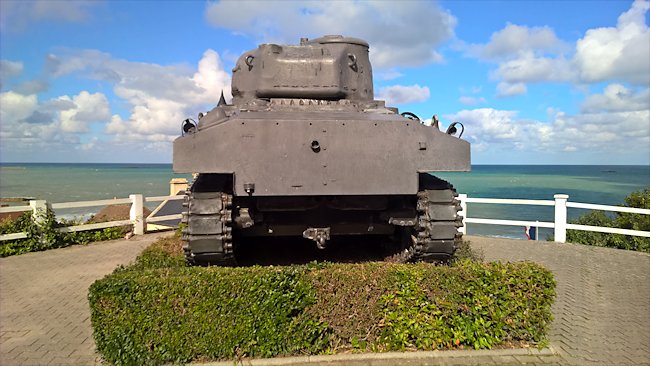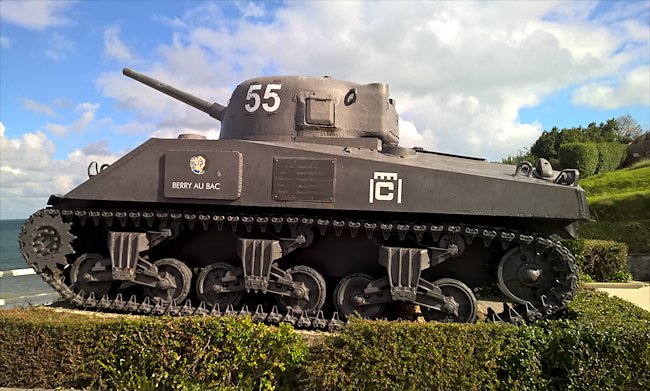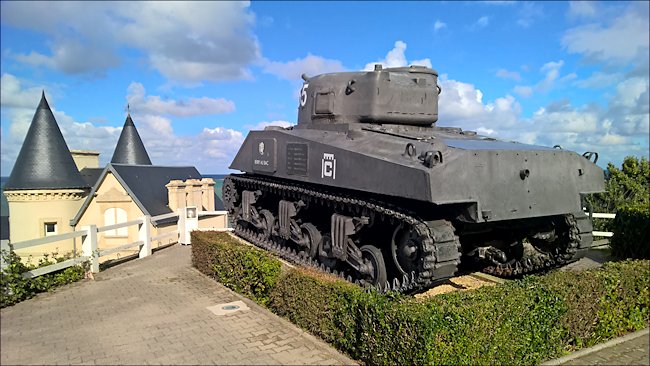Arromanches-les-Bains M4A2 Sherman Tank
This Sherman tank is a WW2 memorial to all the men that fought on Gold Beach in and around Arromanches on and after 6th June 1944 D-Day. It was used by the French Army after the war.

M4A2 Sherman tank D-Day memorial in Arromanches-les-Bains in Normandy
Location
The Sherman tank can be found perched on a ledge that overlooks the Arromanches-les-Bains seafront and Musee du Debarquement D-Day Museum. It is at the junction of the Rue Lucien Joly and Rue Charles Lauent. There is a car park next to the tank. Arromanches is a delightful Normandy seaside town. Yes it is very commercial compared to many of the surrounding coastal resorts but it does have its charm. The sea is full of the large concrete blocks of the D-Day Mulbury Harbour.
The tank is parked on top of an old German Army costal defence concrete Casemate number H612 part of the bunker Wn43. As the allies Attacked the coast on D-Day 6th June 1944 the German Atlantic Wall defence regiments opened fire. A German 105 mm gun was installed in the casement pointing out onto the sea and harbour. The gun slit is now covered with a large steel door which is a shame.

The M4A2 Sherman tank at Arromanches looks out onto Gold Beach area of the D-Day landings 6th June 1944
Specification
The M4A2 Sherman was powered by a General Motors 6046D twin diesel engine. It was a 12-cylinder version of the GM series 71 six cylinder supercharged two stroke engine. It produced 410 hp. A total of 10,968 Sherman M4A2 tanks were manufactured with this engine fitted. (2,915 were fitted with the larger 76mm gun - M4A2(76) Sherman). The tank had a top road speed of 30 mph (48 km/h). The tank needed a 5 man crew: commander, driver, gunner, loader, co-driver/machine gunner.
Its main gun was the standard 75mm medium velocity general purpose gun. It could fire high explosive HE shells as well as armour piercing AP rounds. Although the gun could knock out Panzer III and IV tanks. It could not penetrate the frontal armour of the Panther and Tiger tanks the Allies encountered in the Normandy break out. It also had two 30-60 Browning M1919A4 machine guns: one fitted in the hull and another next to the main gun in the turret. Armour thickness ranged from 25mm to 76mm.

Additional metal plates were welded onto the side of M4A2 Sherman tanks to try and help protect the driver and co-driver.
US Sherman Tank Crew attacks a Panther tank
When it did get light enough to see that the tanks at the bottom of the hill they were indeed German Mark V Panthers, I had my gunner, lay our gun on the closest German tank. He fired. our 75 mm armour piercing AP round but it just bounced off the German tank.
My loader reloaded and we fired again with the same result. I believe we fired three or four rounds of armor piercing ammo at this German Panther. None of our rounds caused him any damage. In the meantime, the German Panther tank had picked up our position from the muzzle blast of our tank gun. He laid his gun on our tank and began firing. After my tank was hit, it began to burn. Than God we all got out safely.

This M4A2 Sherman tanks is parked on top of a German gun emplacement in Arromanches-les-Bains
M4 Sherman Tank Variants
M4: Continental R-975 engine and welded hull. Early vehicles had a three-piece bolted nose, and vision slots (later eliminated) for driver and hull gunner. They had the narrow M34 gun mount. Later production vehicles had a one-piece cast nose and wide M34Al gun mount. Very late production vehicles (late 1943) had a combination cast/rolled hull front. The M4 was built by Pressed Steel (1,000, July 1942-August 1943), Baldwin (1,233, January 1943-January 1944), American Loco (2,150, February-December 1943), Pullman (689, May-September 1943), Detroit Arsenal (1,676, August 1943-January 1944). Total output: 6,748.
M4A1 : As M4 but with cast hull. This was the first model to go into production. Very early production models had M3 type bogie units, M2 75mm gun with counter weights, and twin fixed machine guns in hull front. These guns, plus hull vision slots, were soon eliminated and the M3 75mm gun was introduced after the first few vehicles. Nose was changed from three-piece bolted to one-piece cast, and M34A1 mount and sand shields were added in later vehicles. The M4A1 was built by Lima (1,655, February 1942-September 1943), Pressed Steel (3,700, March 1942-December 1943), Pacific Car and Foundry (926, April 1942-November 1943). Total output: 6,281.
M4A2 : Second type in production, this vehicle differed from the M4 in having twin General Motors 6-71 diesel engines to overcome the shortage of Continental gasoline engines. Production changes effected corresponded with those described for the M4 with the exception of the cast/rolled hull front which never appeared on this model. Very early vehicles had spoked road wheels (as did very early M4A1s) but these were soon abandoned in all models for solid disc type with embossed spokes to simplify production. The M4A2 was built by Fisher/Grand Blanc (4,614, April 1942-May 1944), Pullman (2,737, April 1942-September 1943), American Loco (150, September 1942-April 1943), Baldwin (12, October-November 1942), Federal Welder (540, December 1942-pecember 1943). Total output: 8,053. Used only by USMC. Most went into Lend-Lease stocks.
M4A3: Fifth type in production, this model had a welded hull and was fitted with a 500HP Ford GAA V-8 gasoline engine specially developed for the vehicle. This was the production type most favoured by the US Army and most of these were retained for American use, Lend-Lease deliveries being mainly concentrated on other models. Production changes as for M4 except that this model had the one-piece cast nose for its whole production life. Ford built 1,690 M4A3s from June 1942-September 1943 before ceasing tank production for other munitions work. M4A3 production was then taken over by Grand Blanc from February 1944-March 1945, and numerous improved features were incorporated, including a vision cupola for the commander, a loader's hatch, 4T hull front, and 'wet stowage' for the ammunition. This was the most advanced M4 series vehicle with 75mm gun, the improvements being in line with those in up-gunned variants described below. Total output of improved M4A3 : 3,071.
M4A4: Fourth type in production, this was built only by Detroit Arsenal following on M3 production from July 1942-September 1943. All M4A4s had the three-piece bolted nose, while early vehicles had the M34 gun mount and vision slots in the hull, later eliminated. Late vehicles had the M34Al gun mount which offered better protection to the mantlet. The M4A4 had the Chrysler WC Multibank engine, made from five commercial automobile engines on a common drive shaft. This was another expedient to overcome the engine shortage. To hold this engine it was necessary to lengthen the rear hull to give an overall length of 19ft 101 in. This 370HP unit gave the vehicle a top of 25mph.Total M4A4 output: 7,499.
M4A5: This was the American designation allocated but not used for the Canadian-built Ram Tank which was also developed from the M3 medium series. One Ram was tested by the US Army
M4A6: Final basic model to enter production this was essentially the M4A4 hull and chassis with a newly-developed Caterpillar RD-1820 radial diesel engine of 450HP. It has a lengthened hull like the M4A4 to accommodate the engine and correspondingly lengthened track. Major improvement in the hull was a cast/rolled front to give increased armour production. Detroit Arsenal produced the M4A6, following straight on after M4A4 production ceased. Between October 1943-February 1944, 75 M4A6 vehicles were produced after which orders for this model were cancelled due to production difficulties with the engine and the need to rationalise engine types in use. The same cast/rolled hull front was also used on the last of the Detroit-built M4s, however.
D-Day 1944 books

